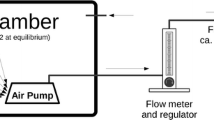Abstract
Slab-on-ground is a typical base floor construction type in Finland. The drainage layer between the slab and soil is a layer of sand, gravel or crushed stone. This layer has a minimum thickness of 200 mm and is sometimes even 600 mm thick, and thus may be a significant contributor to indoor air radon. In order to investigate radon emanation from the drainage layer material, a simple laboratory test was developed. Many organic solvents have high Ostwald coefficients for radon, i.e., the ratio of the volume of gas absorbed to the volume of the absorbing liquid, which enables direct absorption of radon into a liquid scintillation cocktail. Here, we first present equations relating to the processes of gas transfer in emanation measurement by direct absorption into liquid scintillation cocktails. In order to optimize the method for emanation measurement, four liquid scintillation cocktails were assessed for their ability to absorb radon from air. A simple apparatus consisting of a closed glass container holding an open liquid scintillation vial was designed and the diffusion/absorption rate and Ostwald coefficient were determined for a selected cocktail. Finally, a simple test was developed based on this work.
Similar content being viewed by others
References
M. Muikku, H. Arvela, H. Järvinen, H. Korpela, E. Kostiainen, I. Mäkeläinen, K. Vesterbacka, The Mean Effective Dose for Finns — Review 2004, STUK-A211, Dark Ltd., Vantaa, 2005, p. 46 (in Finnish with abstract in English).
J. B. Wadach, C. T. Hess, Health Phys., 48 (1985) 805.
A. Damjær, U. Korsbech, Sci. Total Environ., 45 (1985) 343.
E. Stranden, Health Phys., 44 (1983) 145.
J. Søgaard-Hansen, A. Damjær, Health Phys., 53 (1987) 455.
E. Stranden, A. K. Kolstad, B. Lind, Health Phys., 47 (1984) 480.
J. Rantala, V. Leivo, J. Thermal Env. Bldg. Sci., 28 (2004) 45.
J. Rantala, V. Leivo, Intern. J. Energy Res., 30 (2006) 929.
H. L. Clever (Ed.), Solubility Data Series, Volume 2, Krypton, Xenon and Radon — Gas Solubilities, Pergamon Press, Exeter 1979, p. 261.
L. Salonen, in: J. E. Noakes, F. Schönhofer, H. A. Polach, Liquid Scintillation Spectrometry 1992, Radiocarbon 1993, Braun-Brumfeield, Inc., Michigan, 1993, p. 361.
L. Salonen, H. Hukkanen, J. Radioanal. Nucl. Chem., 226 (1997) 67.
P. Vesterbacka, In-House Guide NAL-10.5 and Regular Report 10.1.2005.
L. A. Currie, Anal Chem., 40 (1968) 586.
Author information
Authors and Affiliations
Corresponding author
Rights and permissions
About this article
Cite this article
Turtiainen, T. Measurement of radon emanation of drainage layer media by liquid scintillation counting. J Radioanal Nucl Chem 279, 325–331 (2009). https://doi.org/10.1007/s10967-007-7315-3
Received:
Published:
Issue Date:
DOI: https://doi.org/10.1007/s10967-007-7315-3




